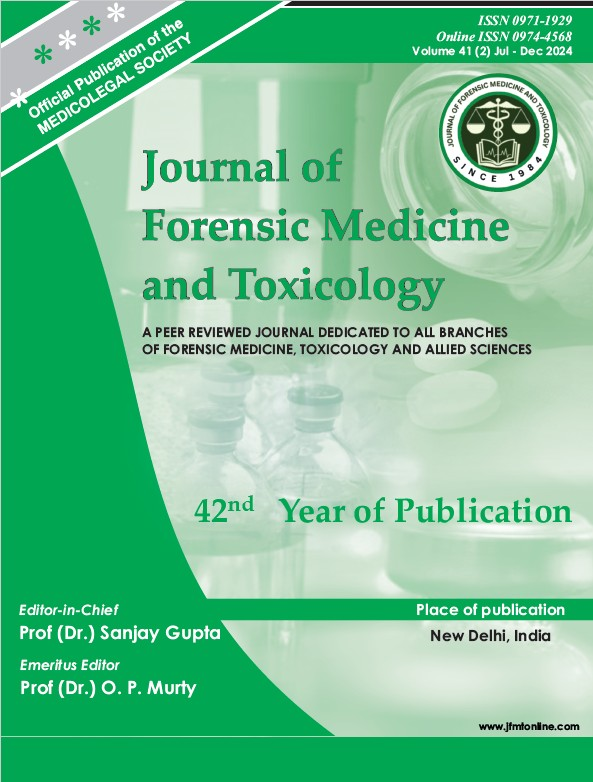TOOTH IMPRINTS AND QUANDARY
DOI:
https://doi.org/10.48165/jfmt.2024.41.2.39Keywords:
Bite Marks, computer generated overlays, hand docking, forensic odontology, ASFOAbstract
The primary aim of this review is to initially analyze the research conducted in India and around the world, focusing on diverse aspects related to bite marks such as their presentation in various media, causative factors, potential distortions, and various techniques to interpret them. Secondly, it aims to scrutinize and summarize resolved cases around the globe that have been documented over the past years, including cases reported in India. Systematic search for articles was done using search engines, including “PubMed, Medline, Embase, Google Scholar, Scopus, and Web of Science”. Bitemarks may be an intriguing tool to be employed in criminal investigations and may be able to provide insight into a case. Forensic Odontologists have been accused of misrepresenting the unique nature of human dentition and of disregarding the unpredictable nature of tooth marks on the skin. As a result, bitemark evidence has been characterized as unreliable due to its lack of sensitivity and specificity, leading critics to assert that any conclusions drawn from bitemark evidence must be invalid. Throughout this review, we have analyzed various studies conducted worldwide and tabulated them according to different criteria. Furthermore, solved cases have been reviewed to see the effectiveness of BM cases solved and presented in court of Law.
Downloads
References
Mancellos J, et al. Legal Validity of Criminal Identification from the Comparative Analysis of Bitemarks. Acta Scientific Dental Sciences. 2020;4(8):02-10.
Kaur S, Krishan K, Chatterjee P, Kanchan T. Analysis and identification of Bitemarks in forensic casework. Oral Health and Dental Management. 2013;12:127-31.
Mahakalkar A, Mehar P. Forensic perspective behind bite-marks: an e-survey. Frontiers in Life Science. 2022; 8:40-49.
Robinson L, Bernitz H. You can run, but you can’t hide - A bitemark analysis. SADJ: Journal of the South
African Dental Association. 2021;76:138-141.
Bush MA, Cooper HI, Dorion RB. Inquiry into the scientific basis for bitemark profiling and arbitrary distortion compensation. J Forensic Sci. 2010 Jul;55(4):976-83
Evans S, Noorbhai S, Lawson Z, Stacey-Jones S, Carabott R. Contrast enhancement of bite mark images using the grayscale mixer in ACR in Photoshop®. J Forensic Sci. 2013;58(3):804-10.
Lorkiewicz-MD, Rychlik M, Glapiñski M, £abêdzka M, Œwiderski P, ¯aba C. The Effectiveness of 2D and 3D Methods in the Analysis of Experimental Bite Marks. Dental and Medical Problems. 2015;52:86–92.
Tai MW, Chong ZF, Asif MK, Rahmat RA, Nambiar P. A comparative study between xerographic, computer-assisted overlay generation and animated superimposition methods in bite mark analyses. Leg Med (Tokyo). 2016;22:42-8.
Dama N, Scheila M S, Revie G, Forgie A. Exploring the degrees of distortion in simulated human bite marks. Int J Legal Med. 2020 May;134(3):1043-1049.
Deshpande U, Scheila MS. Exploring bite marks on different types of skin tones. Rev Bras Odontol Leg RBOL 2019;6(1):40-46.
Patil S, Rao R, Raj AT. A Comparison Between Manual and Computerized Bite-Mark Analysis. Journal of Advanced Oral Research. 2013;4(3):1-5.
Pallam NK, Boaz K, Natarajan S, Raj M, Manaktala N, Lewis A. Computer–based method of bite mark analysis: A benchmark in forensic dentistry? Journal of Forensic Dental Sciences. 2016;8:32.
Chintala L, Manjula M, Goyal S, Chaitanya V, Hussain MK, Chaitanya YC. Human bite marks – A computer based analysis using Adobe Photoshop. Journal of Indian Academy of Oral Medicine and Radiology. 2018;30:58.
Maji A, Khaitan T, Sinha R, Sarkar S, Verma P, Shukla AK. A Novel Computer-Assisted Method of Bite Mark Analysis for Gender Determination. J Environ Public Health. 2018;1-4.
Bhagat S, Gupta V, Tyagi N, Sharma E, Gupta S, Dadu M. Berry’s index: Adjuvant to bite marks. Journal of Forensic Dental Sciences. 2018; 10(1):45-49
Giri S, Tripathi A, Patil R, Khanna V, Singh V. Analysis of bite marks in foodstuffs by CBCT 3D reconstruction. J Oral Biol Craniofac Res. 2019;9(1):24- 27.
Lessig R, Wenzel V, Weber M. Bite mark analysis in forensic routine casework. EXCLI Journal 2006;5:93- 102
Afsin H, Karadayi B, çaðdýr A, Özaslan A. Role of bite mark characteristics and localizations in finding an assailant. Journal of Forensic Dental Sciences. 2014;6:117-121.
Robinson L, Bernitz H. You can run, but you can’t hide - A bitemark analysis. SADJ: Journal of the South African Dental Association. 2021;76:138-141.
Jimsha VK, Shakila R, Jonathan D, Ramesh V, Marak F. Bite mark analysis: A case report. Journal of Indian Academy of Forensic Medicine. 2020;42(1):66–69.
Padmakumar S, Beena VT, Salmanulfaris N, Acharya A, Indu G, Kumar S. Bite Mark Analysis. Oral Maxillofac Pathol J 2014;5(2):488-490.
Pandey H. Forensic Dental Evidence in a case of sexual assault and homicide of a minor girl in India: A Case Report. Journal of Indian Academy of Forensic Medicine. 2021;42:231.
Saks M, Albright T, Bohan T, Bierer B, Bowers C, Bush M, Bush P, Casadevall A, Cole S, Denton B, Diamond S, Dioso-Villa R, Epstein J, Faigman D, Faigman L, Fienberg S, Garrett B, Giannelli P, Greely H, Zumwalt R. Forensic bitemark identification: weak foundations, exaggerated claims. Journal of Law and the Biosciences. 2016;3:538-575.
Barsley RE, Bernstein ML, Brumit PC, Dorion RBJ, Golden GS, Lewis JM, McDowell JD, Metcalf RD, Senn DR, Sweet D, Weems RA. Epidermis and Enamel: Insights Into Gnawing Criticisms of Human Bitemark Evidence. Am J Forensic Med Pathol. 2018;39(2):87- 97.
Araújo L, Frontanilla T, Jacometti V, Costa P, Alves da Silva RH. Stability Analysis of Bitemarks in Different Conditions of Time and Temperature and Its Reliability as Evidence in Criminal Investigations. Brazilian Dental Journal. 2019;30:295-302.




